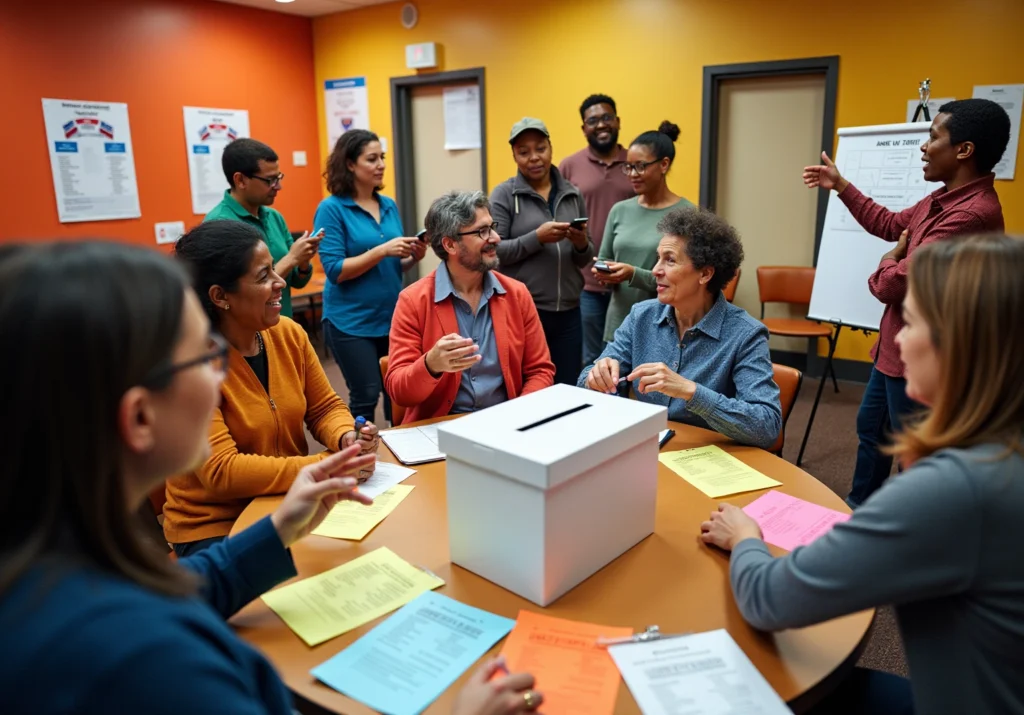Overview
The article emphasizes the implementation of instant runoff voting (IRV) for union elections, highlighting its critical role in enhancing member participation and representation. By detailing the benefits of IRV—such as increased voter engagement, reduced negative campaigning, and improved representation for diverse groups—it captures the attention of union leadership. Furthermore, it outlines the essential steps necessary for effective implementation, thereby building interest and generating a desire for this solution.
Increased voter engagement is a key advantage of IRV, as it encourages more members to participate in the electoral process. This method not only reduces negative campaigning but also fosters an environment where diverse voices are better represented. In addition, the article provides a comprehensive outline of the steps required for successful implementation, ensuring that union leaders are well-informed and prepared to take action.
Ultimately, adopting IRV can transform union elections, leading to a more engaged and representative membership. Union leadership is encouraged to consider this approach seriously, as it holds the potential to enhance the democratic process within their organizations.
Introduction
Instant runoff voting (IRV) represents a significant advancement in electoral innovation, particularly within labor unions where member engagement is essential. This method empowers voters to articulate nuanced preferences, thereby enhancing the representativeness of election outcomes.
However, as unions contemplate the adoption of this transformative system, they encounter the challenge of implementing IRV effectively while ensuring transparency and comprehension among their members.
What strategic steps can union leaders take to navigate this complex transition and fully harness the advantages of ranked-choice voting?
In addressing these questions, it is crucial to consider the broader implications of IRV on union democracy and member satisfaction.
Define Instant Runoff Voting and Its Importance for Unions
Instant runoff voting (IRV), often called ranked-choice voting (RCV), is a crucial electoral system that allows participants to rank options according to their preferences. In instances where no candidate secures a majority of first-choice votes, the candidate with the least support is eliminated, prompting a redistribution of their votes to remaining candidates according to voters’ subsequent preferences. This iterative process persists until a candidate achieves majority support.
For labor unions, the adoption of instant runoff is essential, as it markedly enhances member participation and satisfaction. By allowing members to articulate their preferences more fully, IRV yields outcomes that more accurately mirror the collective will of the union. This method and fosters a broader array of candidates to vie for election, recognizing they have a viable path to victory even if they are not the primary choice of the majority.
Research substantiates that jurisdictions implementing RCV witness a significant uptick in participation, with some studies reporting a 10-point increase compared to traditional elections. Moreover, RCV elections result in a median increase of 17% in vote counts for finalists relative to conventional methods. A case in point is Santa Fe’s 2018 mayoral election, where RCV contributed to a 51% rise in totals for finalists, enabling approximately 6,700 additional participants to influence the outcome. This exemplifies how instant runoff can bolster the democratic process within unions, cultivating a more engaged and representative membership base.
Furthermore, RCV has been shown to enhance representation for women and individuals of color, a crucial aspect for unions striving to reflect their membership’s diversity. As Deb Otis, Director of Research and Policy at FairVote, notes, “RCV results in an average of 17% more ballots directly influencing the outcome between candidates who genuinely have a chance at winning – equivalent to millions more individuals casting a significant vote.” By embracing instant runoff, unions can foster a more inclusive electoral environment, ultimately fortifying their democratic foundations and ensuring that every voice is acknowledged.
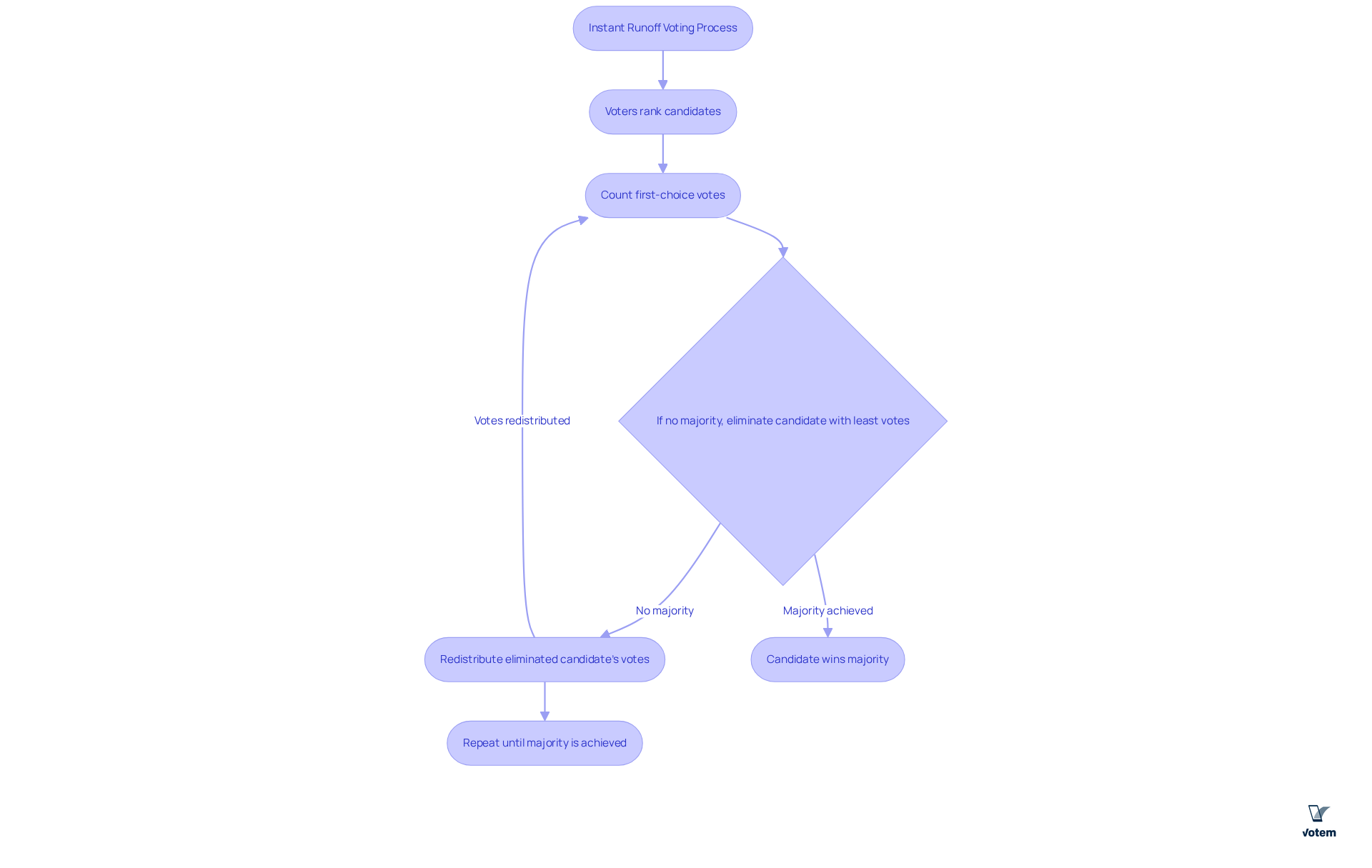
Outline the Process of Instant Runoff Voting
Conducting an instant runoff election requires several essential steps to ensure a smooth and effective process, alongside considerations that enhance voter engagement and understanding.
Preparation: Begin by verifying that all qualified individuals are registered. It is crucial to inform them about the election procedure and provide clear guidance on how to rank options effectively. Strong educational initiatives for electors can significantly boost the number of meaningful selections. Research indicates that instant runoff voting can enhance participation by allowing individuals to express their preferences without the fear of wasting their vote.
Voting: Voters receive a ballot that enables them to rank candidates in order of preference, indicating their first choice, second choice, and so on. This method implements instant runoff to ensure that if a voter’s primary selection is eliminated, their ballot continues to support their next preferred candidate, thereby increasing the likelihood that their choice will influence the outcome.
Counting Ballots: After the polling period concludes, first-choice selections are counted. If a candidate secures a majority (more than 50%), they are declared the winner. If no candidate achieves a majority, the individual with the least support is removed.
Elimination and Redistribution: The ballots of the eliminated candidate are reassigned to the remaining participants based on the subsequent preferences indicated on the ballots. This process continues until a candidate obtains a majority of the ballots.
Repeat: Steps 3 and 4 are repeated until a candidate receives a majority of the votes. This iterative process, which incorporates instant runoff, ensures that every voice is heard and that the final outcome accurately reflects the electorate’s preferences.
Announcement: Once a candidate has achieved a majority, they are declared the winner, and the results are communicated to all members. Transparency in presenting the results is essential to in the electoral process.
By adhering to these steps and considering the broader context of education and engagement, union leaders can facilitate a transparent election process that accurately reflects their members’ preferences. This approach ultimately enhances involvement and trust in the electoral system. As noted by Deb Otis from FairVote, “With ranked choice voting, 17% more votes make a difference,” underscoring the significance of this method in modern elections.
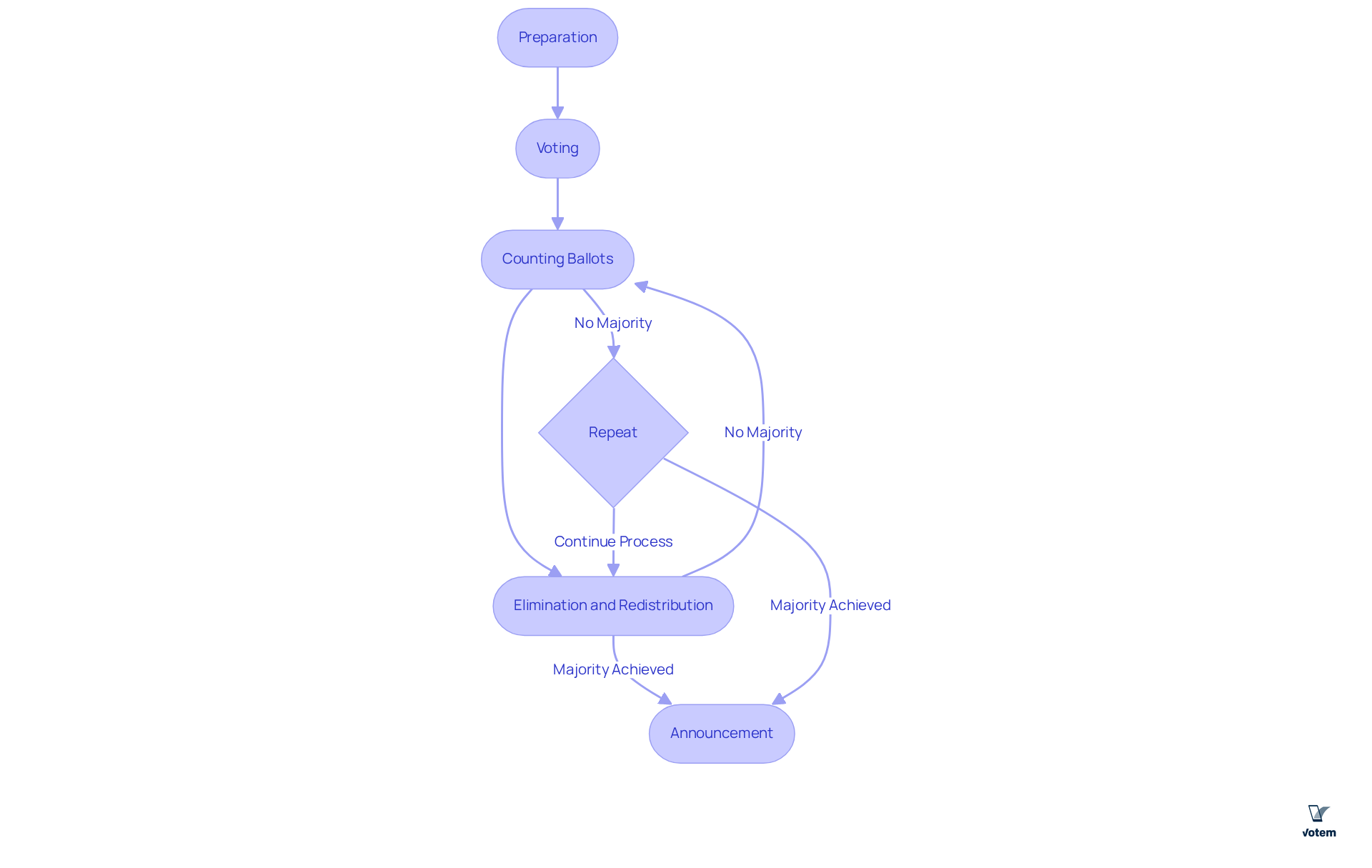
Analyze the Outcomes of Instant Runoff Voting
The implementation of instant runoff can profoundly reshape the electoral dynamics within unions. Consider the following key outcomes:
- Increased Voter Engagement: Research indicates that IRV can significantly boost voter turnout, as members feel their preferences are more accurately represented. In jurisdictions utilizing ranked-choice voting, voter turnout has been shown to increase by up to 10%, particularly among younger voters and communities of color. Notably, in RCV elections, the rate of inactive ballots is only 6%, significantly lower than the 17% of additional meaningful votes counted, ensuring that more voices are heard.
- Diverse Participant Representation: IRV promotes a broader spectrum of individuals, allowing them to appeal to a wider audience beyond their first-choice supporters. This inclusivity can lead to more moderate candidates gaining traction, as evidenced by the success of candidates in RCV elections who have attracted backing from varied electorates.
- Reduction of Negative Campaigning: Candidates are motivated to engage in positive campaigning, aiming to secure second or third-choice support from those who may not initially back them. This shift can foster more civil discourse and constructive political discussions, enhancing the overall electoral environment.
- Complexity in Counting: Despite its advantages, IRV introduces complexities in the counting process. are crucial to ensure individuals comprehend how their rankings convert into votes, thus reducing confusion. For instance, effective education programs for electors should emphasize how to correctly fill out a ranked ballot and encourage individuals to use multiple rankings.
- Potential for Exhausted Ballots: Some individuals may opt not to rank all participants, resulting in ‘exhausted’ ballots that do not count in subsequent rounds. This issue can be addressed through effective electoral education initiatives, emphasizing the significance of ranking multiple candidates to maximize the impact of their votes. In the context of New York City’s 2021 primaries, the implementation of instant runoff resulted in the highest participation in over 30 years, illustrating the effectiveness of instant runoff in enhancing electoral engagement.
By examining these outcomes, union leaders can gain valuable insights into how IRV can enhance their electoral processes while proactively addressing potential challenges.
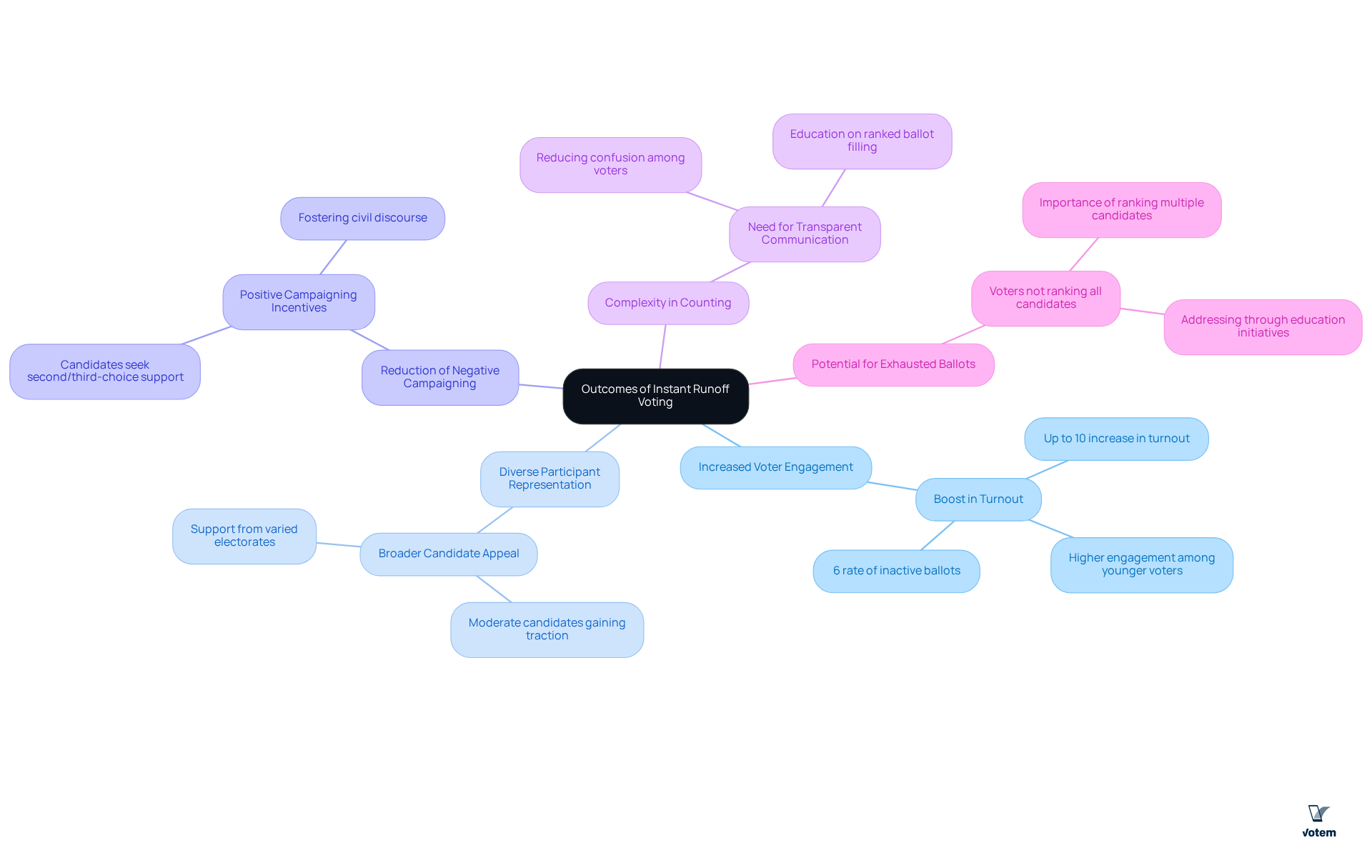
Provide Resources for Implementing Instant Runoff Voting
To effectively implement instant runoff, union leaders can utilize a variety of resources that enhance engagement and understanding among members.
- Educational Materials: Distributing brochures or online resources that clearly explain how instant runoff works, its advantages, and the steps for members to participate effectively is crucial. This can significantly enhance understanding and engagement among union members. For instance, 90% of surveyed voters in the Maine 2018 primary reported their experience with IRV as ‘excellent’ or ‘good,’ indicating a positive reception that can be highlighted in these educational materials.
- Training Sessions: Organizing workshops or webinars aimed at training election officials and members on the instant runoff process is essential. These sessions should cover and strategies for addressing potential challenges during elections. Involving specialists such as Deb Otis, who points out that RCV leads to an average of 17% more ballots influencing the result, can offer valuable insights during these sessions.
- Software Tools: Investing in election management software that supports instant runoff can streamline the counting process, ensuring accuracy and efficiency in managing votes. The mobile-first user experience of platforms like Votem can boost turnout by up to three times on launch day, making it a compelling option for unions.
- Legal Guidance: Seeking advice from legal experts is vital to ensure that all aspects of the IRV implementation comply with labor laws and regulations governing union elections.
- Case Studies: Analyzing case studies from other unions or organizations that have successfully adopted instant runoff provides valuable insights. For example, the 2022 election for Maine’s 2nd Congressional District demonstrated the effectiveness of instant runoff by allowing nearly 17,000 voters to have their ballots count toward a finalist, thus enhancing voter engagement and turnout.
- Support Networks: Engaging with networks or associations dedicated to electoral reform can facilitate the sharing of experiences and insights among union leaders, fostering a collaborative approach to implementing instant runoff.
By leveraging these resources, union leaders can significantly enhance the democratic process within their organizations, ensuring that elections are conducted fairly and effectively.
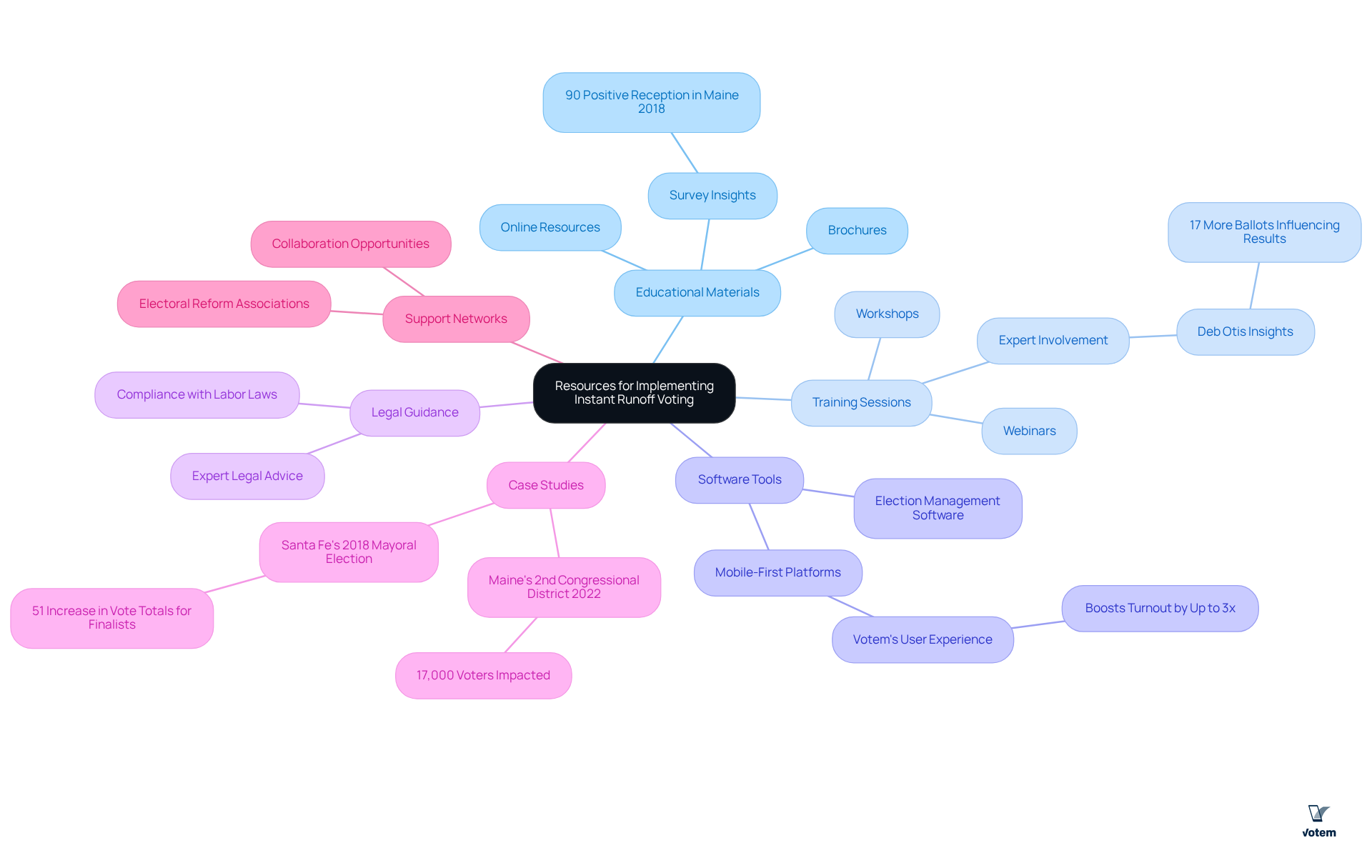
Conclusion
Implementing instant runoff voting (IRV) presents a transformative opportunity for labor unions to enhance their electoral processes and member engagement. By adopting this system, unions can ensure that every member’s voice is heard, leading to more representative outcomes that genuinely reflect the collective will. The iterative nature of IRV not only promotes inclusivity but also encourages a broader range of candidates, ultimately fostering a healthier democratic environment within unions.
The article outlines essential steps for implementing IRV, emphasizing the importance of preparation, education, and transparent communication throughout the voting process. Key benefits such as increased voter turnout, diverse representation, and reduced negative campaigning are highlighted, alongside potential challenges like the complexities of ballot counting and the risk of exhausted ballots. By addressing these challenges through effective training and resource allocation, union leaders can create an electoral system that empowers their members.
In conclusion, the shift to instant runoff voting is not merely a procedural change; it is a commitment to enhancing democracy within unions. By embracing this method, union leaders can cultivate an engaged and representative membership, ensuring that every voice contributes to the direction of their organization. The time to act is now—implementing IRV can pave the way for a more inclusive and effective electoral process, ultimately strengthening the foundations of union democracy for years to come.
Frequently Asked Questions
What is Instant Runoff Voting (IRV) and how does it work?
Instant runoff voting (IRV), also known as ranked-choice voting (RCV), is an electoral system that allows voters to rank candidates according to their preferences. If no candidate receives a majority of first-choice votes, the candidate with the least support is eliminated, and their votes are redistributed to the remaining candidates based on voters’ subsequent preferences. This process continues until a candidate achieves majority support.
Why is IRV important for labor unions?
The adoption of instant runoff voting is essential for labor unions as it enhances member participation and satisfaction. It allows members to express their preferences more fully, leading to outcomes that better reflect the collective will of the union. Additionally, IRV reduces the risk of ‘lost’ ballots and encourages a wider range of candidates to run for election.
How does IRV impact voter participation?
Research indicates that jurisdictions using ranked-choice voting experience a significant increase in voter participation, with some studies showing a 10-point rise compared to traditional elections.
Can you provide an example of IRV increasing voter turnout?
A notable example is the 2018 mayoral election in Santa Fe, where ranked-choice voting led to a 51% increase in vote totals for finalists, allowing approximately 6,700 additional participants to influence the outcome.
How does IRV promote diversity and representation within unions?
Ranked-choice voting has been shown to enhance representation for women and individuals of color, which is important for unions aiming to reflect their diverse membership. It results in more ballots directly influencing the outcome between viable candidates, thereby fostering a more inclusive electoral environment.
What are the broader implications of adopting IRV for unions?
By embracing instant runoff voting, unions can strengthen their democratic foundations, ensure that every voice is acknowledged, and cultivate a more engaged and representative membership base.
List of Sources
- Define Instant Runoff Voting and Its Importance for Unions
- fairvote.org (https://fairvote.org/report/more-votes-make-a-difference)
- Does ranked choice Voting Increase voter turnout and mobilization? (https://sciencedirect.com/science/article/pii/S026137942400074X)
- Research and data on RCV in practice – FairVote (https://fairvote.org/resources/data-on-rcv)
- The future of the instant runoff election reform | Brookings (https://brookings.edu/articles/the-future-of-the-instant-runoff-election-reform)
- Outline the Process of Instant Runoff Voting
- fairvote.org (https://fairvote.org/report/more-votes-make-a-difference)
- The future of the instant runoff election reform | Brookings (https://brookings.edu/articles/the-future-of-the-instant-runoff-election-reform)
- Analyze the Outcomes of Instant Runoff Voting
- The future of the instant runoff election reform | Brookings (https://brookings.edu/articles/the-future-of-the-instant-runoff-election-reform)
- FairVote.org | Quotes from Student Leaders on IRV (https://archive3.fairvote.org/reforms/instant-runoff-voting/where-rcv-is-used-2/colleges-and-universities-using-ranked-choice-voting/quotes-from-student-leaders-on-irv)
- Does ranked choice Voting Increase voter turnout and mobilization? (https://sciencedirect.com/science/article/pii/S026137942400074X)
- fairvote.org (https://fairvote.org/report/more-votes-make-a-difference)
- Research and data on RCV in practice – FairVote (https://fairvote.org/resources/data-on-rcv)
- Provide Resources for Implementing Instant Runoff Voting
- FairVote.org | Quotes from Student Leaders on IRV (https://archive3.fairvote.org/reforms/instant-runoff-voting/where-rcv-is-used-2/colleges-and-universities-using-ranked-choice-voting/quotes-from-student-leaders-on-irv)
- fairvote.org (https://fairvote.org/report/more-votes-make-a-difference)
- Ranked choice voting – SciLine (https://sciline.org/elections/ranked-choice-voting-quotes)
- Instant runoff voting | MIT Election Lab (https://electionlab.mit.edu/research/instant-runoff-voting)
- Research and data on RCV in practice – FairVote (https://fairvote.org/resources/data-on-rcv)

